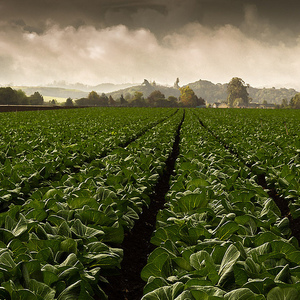Farming in California has become more difficult in recent years as there aren’t enough people to do the arduous work involved in farming. Incentives of higher pay don’t always work to attract enough workers. So the owner of one California farm has adjusted to this labor shortage in a few different ways and reached a conclusion about the cause of his problem and the best way to solve it. Listen to find out about the surprising decision he has made.
Listen to the story
RACHEL MARTIN: Dollar for dollar, California is the biggest agriculture economy in this country. And lately, farmers in that state have been struggling with a new kind of problem. They don’t have enough workers to harvest crops. Cardiff Garcia and Stacey Vanek Smith of our Planet Money team went to a celery farm in California to find out more.
CARDIFF GARCIA: We went to Oxnard, Calif., to talk with Tom Deardorff. His family has owned farms in this area for decades.
TOM DEARDORFF: There’s probably 80 acres of celery here in the field that we’re at right now. Every single stock of celery needs to get cut by hand.
STACEY VANEK SMITH: In the middle of the ocean of celery, there is a crew of about 30 workers? They walk in a row in big straw hats, hacking off celery stalks and tossing them onto this motorized platform which stretches across the field and chugs along behind them.
It is really hard and dangerous work, 10-hour days swinging a knife in the hot sun. And when the job market’s strong, like it has been for the last few years, these workers have a lot of other options.
DEARDORFF: They move into – whether it’s landscaping jobs, construction jobs, food service jobs.
GARCIA: So Tom Deardorff has had to compete for workers. He’s raised their pay by actually quite a lot. Back in 2006, working the celery field paid about $8.70 an hour. Now it pays more than $21 an hour. We couldn’t speak to any of the workers on Tom’s farm. But Tom says his workers all are documented and that even doubling wages hasn’t solved the labor problem.
DEARDORFF: Yeah I don’t think it’s an economic issue. I think it’s a political issue.
GARCIA: Tom says the agriculture visas that the country offers – they’re too difficult to get, they’re expensive and there just aren’t enough of them. Deardorff Farms used to hire more than 600 workers every year. But Tom says he can’t make that happen anymore, so he’s had to make changes to his business.
DEARDORFF: We’ve shifted away from the most labor-intensive crops – so things like vine-ripe tomatoes, we no longer grow anymore. We’ve also shifted a large amount of our production down into Mexico. So basically, the fact of the matter is that a foreign-born person is going to be harvesting your fruits and vegetables. So the decision is – do we want to do that within the United States, or do we want to have that foreign-born worker stay in his country and harvest your fruits and vegetables? So based on what we’ve seen in the political environment over the last 15 and 20 years, we have decided to go down there into Mexico.
GARCIA: And now with President Trump signaling that he wants to crack down on undocumented workers, the labor situation might get even harder.
VANEK SMITH: Even if Tom only hires documented workers, he could feel the pinch because if undocumented workers leave the area, the overall supply of farm workers goes down. So more and more farmers could find themselves moving their operations to Mexico.
GARCIA: How hard was it to make these kinds of decisions based on, like, what you were seeing?
DEARDORFF: I mean, if I was looking at spreadsheets all day long, it was a really simple decision and one we probably should have made five years before we made it. But I mean, these are ranches that my great-grandfather farmed, and we’d rather keep them active. But the economics and the politics of it are suggesting that we do otherwise. So…
VANEK SMITH: Tom says his business has become this constant calculation of how to harvest more with less because, in spite of everything – the higher pay, the different crops – his turnover rate keeps growing. Fewer and fewer of the same workers come back to his farms every year.
 © 2018 National Public Radio, Inc. Used with the permission of NPR. All rights reserved.
© 2018 National Public Radio, Inc. Used with the permission of NPR. All rights reserved. Vocabulary
- documented worker – a worker from a country other than the United States who has been given the right to work legally in the U.S.
- visa – an endorsement on a passport allowing someone to enter, stay, or leave a country for a specific amount of time
- labor-intensive – concerning a task, requiring a lot of work and, often, many workers to complete
- spreadsheet – a document used to track data such as costs
Listening Comprehension Questions
- What problem has Tom Deardorff encountered?
- What changes has he made in order to address the problem, and how well have they worked?
- What does he believe is the root cause of his problem? What evidence does the story offer to support his belief?
- What decision has Deardorff made about his farm business, and what is ironic about this decision?
Discussion Themes
- What are some other ways that US politics affects economics?
- Based on what you heard, how would you recommend the government address the worker shortage? Explain your answer.
Teacher’s Guide
Activate student knowledge: Open class by asking students to think about what an employer might do to encourage people to work for him or her. Then explain that sometimes these “encouragements”—economists call them incentives—don’t work. That’s because other factors can interfere. Ask students what they know about the debate about immigration in the United States. Point out that it has become increasingly difficult for migrants to enter the country at the border with Mexico as government policies and some Americans’ attitudes have emphasized the need to keep non-citizens out of the country, preserve jobs for American citizens, and keep American businesses from moving overseas. Ask them to think about how these attitudes and policies might affect not just potential immigrants, but also businesses in the United States.
Introduce the story: In this audio story, you will hear from farmer Tom Deardorff, who has had trouble finding enough workers to staff his California farm. Listen to hear what he’s done to attract and keep workers, and what he’s decided to do when those methods haven’t succeeded.
Active listening supports: Choose one of the following listening organizers to support student understanding as they listen to the story.
- The Fill in the Blanks exercise will guide student listening as they takes notes on the audio story.
- The Language Identification organizer allows students to follow along and track important phrases while listening to the story.
Reflect on the story: Take time for student reflection on the audio story and discussion questions to check for understanding. Encourage students to think about the irony of a farmer moving his business to Mexico because he can’t hire enough Mexican workers to work in California. Urge them to think more generally about how politics can affect businesses.
Paired Text: Use the transcribed Harvest public Media radio report Farmers Are Seeking More Temporary H-2A Workers And Keeping Them Longer to pair with this audio story. This report provides a broader picture of the challenges employers face when they want to hire foreign migrants to do farm work. Ask students how this additional information affects their understanding of the audio story.
Listening Organizers
External Materials
- Paired text: Farmers Are Seeking More Temporary H-2A Workers And Keeping Them Longer
- Fact Sheet: H2-A Program for Temporary Agricultural Workers
- Article: Immigrant Labor
- Article: Legislation aims to curb shortage of agricultural workers
- Article: New Department of Labor Numbers Show Farmers Are Increasingly Turning to this Controversial Visa Program
- Article: Close to Slavery: Guest Worker Programs in the United States


